#T.J. Cobden-Sanderson
Explore tagged Tumblr posts
Text
Remnants of a Legendary Typeface Have Been Rescued From the River Thames
Doves Type was thrown into the water a century ago, following a dispute between its creators.
by Holly Black - Artnet, May 5, 2024

Doves Type recovered by Robert Green, 2014. Photo Matthew Williams Ellis
The depths of the river Thames in London hold many unexpected stories, gleaned from the recovery of prehistoric tools, Roman pottery, medieval jewelry, and much more besides. Yet the tale of the lost (and since recovered) Doves typeface is surely one of the most peculiar.
A little over a century ago, the printer T.J. Cobden-Sanderson took it upon himself to surreptitiously dump every piece of this carefully honed metal letterpress type into the river. It was an act of retribution against his business partner, Emery Walker, whom he believed was attempting to swindle him.
The pair had conceived this idiosyncratic Arts and Crafts typeface when they founded the Doves Press in the London’s Hammersmith neighborhood, in 1900. They worked with draftsman Percy Tiffin and master punch-cutter Edward Prince to faithfully recall the Renaissance clarity of 15th-century Venetian fonts, designed by the revolutionary master typographer Nicolas Jensen.
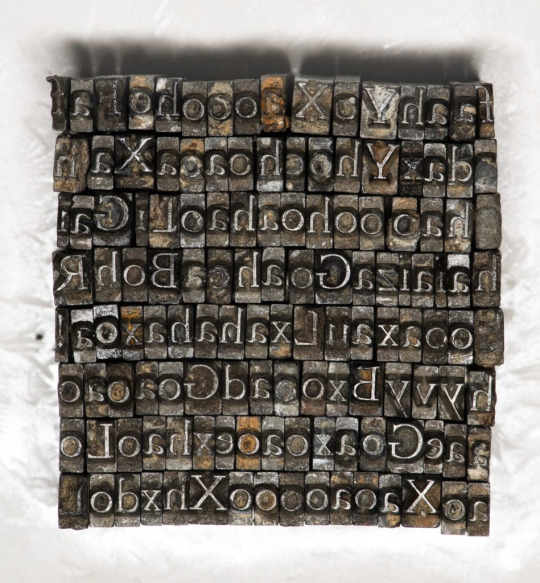
Doves Type recovered by Robert Green, 2014. Photo Matthew Williams Ellis
With its extra-wide capital letters, diamond shaped punctuation and unique off-kilter dots on the letter “i,” Doves Type became the press’s hallmark, surpassing fussier typographic attempts by their friend and sometime collaborator, William Morris.
The letterforms only existed as a unique 16pt edition, meaning that when Cobden-Sanderson decided to “bequeath” every single piece of molded lead to the Thames, he effectively destroyed any prospect of the typeface ever being printed again. That might well have been the case, were it not for several individuals and a particularly tenacious graphic designer.
Robert Green first became fascinated with Doves Type in the mid-2000s, scouring printed editions and online facsimiles, to try and faithfully redraw and digitize every line. In 2013, he released the first downloadable version on typespec, but remained dissatisfied. In October 2014, he decided to take to the river to see if he could find any of the original pieces.
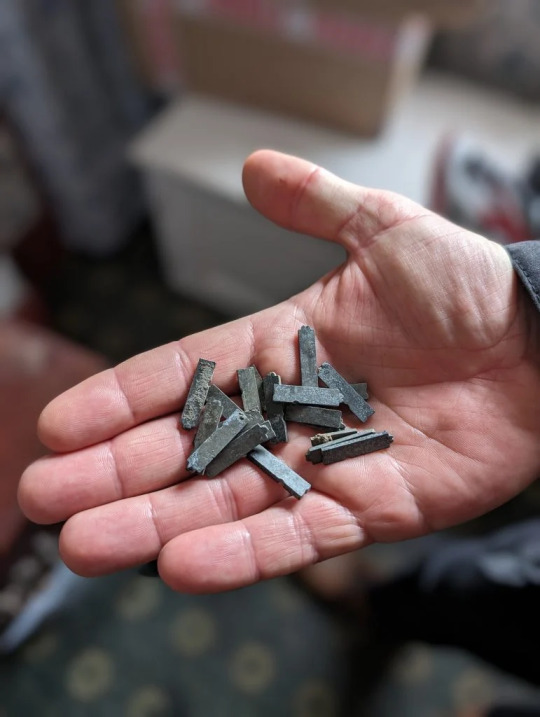
Doves Type recovered and held here by Lukasz Orlinski at Emery Walker’s House. Photo: Lucinda MacPherson.
Using historical accounts and Cobden-Sanderson’s diaries, he pinpointed the exact spot where the printer had offloaded his wares, from a shadowy spot on Hammersmith bridge. “I’d only been down there 20 minutes and I found three pieces,” he said. “So, I got in touch with the Port of London Authority and they came down to search in a meticulous spiral.” The team of scuba divers used the rather low-tech tools of a bucket and a sieve to sift through the riverbed.
Green managed to recover a total of 151 sorts (the name for individual pieces of type) out of a possible 500,000. “It’s a tiny fraction, but when I was down by the river on my own, for one second it all felt very cosmic,” he said. “It was like Cobden-Sanderson had dropped the type from the bridge and straight into my hands. Time just collapsed.”
The finds have enabled him to further develop his digitized version and has also connected him with official mudlarks (people who search riverbanks for lost treasures, with special permits issued) who have uncovered even more of the type.

A mudlark by the Thames with Hammersmith Bridge in background. Photo: Lucinda MacPherson.
Jason Sandy, an architect, author and member of the Society of Thames Mudlarks, found 12 pieces, which he has donated to Emery Walker’s House at 7 Hammersmith Terrace. This private museum was once home to both business partners, and retains its stunning domestic Arts and Crafts interior.
Much like Green, Sandy was captivated by the Doves Type story, and mounted an exhibition at the house that displays hundreds of these salvaged pieces, including those discovered by Green, as well as mudlarks Lucasz Orlinski and Angus McArthur. The show was supplemented by a whole host of Sandy’s other finds, including jewelry and tools. An extant copy of the Doves English Bible is also on display.
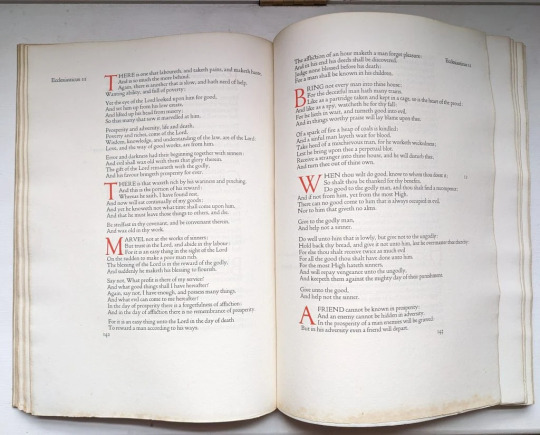
The Doves Bible returns to Emery Walker’s House. Photo: Lucinda MacPherson.
“It is not that unusual to find pieces of type in the river,” Sandy said. “Particularly around Fleet Street, where newspaper typesetters would throw pieces in the water when they couldn’t be bothered to put them back in their cases. But this is a legendary story and we mudlarks love a good challenge.” The community is naturally secretive about exactly where and how things are found. For example, Orlinski has worked under the cover of night with a head torch, to search for treasures at his own mysterious spot on the riverbank.
For Sandy, the thrill comes from the discovery of both rare and everyday artifacts, which can lead to an entirely new line of inquiry: “The Thames is very democratic. It gives you a clear picture of what people have been wearing or using over thousands of years. And it’s not carefully curated by a museum. The river gives up these objects randomly, and you experience these amazing stories of ordinary Londoners. It creates a very tangible connection to the past. Every object leads you down a rabbit hole.”
“Mudlarking: Unearthing London’s Past” is at Emery Walker’s House, 7 Hammersmith Terrace, London, through May 30.
#Doves typeface#letterpress type#letterpress printing#T.J. Cobden-Sanderson#Emery Walker#Emery Walker's House#Robert Green#Jason Sandy#mudlarking#Artnet#May 2024#long post
4 notes
·
View notes
Text

POEMS by Dante Gabriel Rossetti [Kelmscott Press, 1891] Cover design by T.J. Cobden-Sanderson, founder of Doves Press.
source2
#beautiful books#book blog#books books books#book cover#books#vintage books#illustrated book#book design#kelmscott press#poetry#dante gabriel rossetti#cobden-sanderson
109 notes
·
View notes
Text

Remnants of a Legendary Typeface Have Been Rescued From the Thames River
Doves Type was thrown into the water a century ago, following a dispute between its creators.
The depths of the river Thames in London hold many unexpected stories, gleaned from the recovery of prehistoric tools, Roman pottery, medieval jewelry, and much more besides. Yet the tale of the lost (and since recovered) Doves typeface is surely one of the most peculiar.
A little over a century ago, the printer T.J. Cobden-Sanderson took it upon himself to surreptitiously dump every piece of this carefully honed metal letterpress type into the river. It was an act of retribution against his business partner, Emery Walker, whom he believed was attempting to swindle him.
The pair had conceived this idiosyncratic Arts and Crafts typeface when they founded the Doves Press in the London’s Hammersmith neighborhood, in 1900. They worked with draftsman Percy Tiffin and master punch-cutter Edward Prince to faithfully recall the Renaissance clarity of 15th-century Venetian fonts, designed by the revolutionary master typographer Nicolas Jensen.

With its extra-wide capital letters, diamond shaped punctuation and unique off-kilter dots on the letter “i,” Doves Type became the press’s hallmark, surpassing fussier typographic attempts by their friend and sometime collaborator, William Morris.
The letterforms only existed as a unique 16pt edition, meaning that when Cobden-Sanderson decided to “bequeath” every single piece of molded lead to the Thames, he effectively destroyed any prospect of the typeface ever being printed again. That might well have been the case, were it not for several individuals and a particularly tenacious graphic designer.
Robert Green first became fascinated with Doves Type in the mid-2000s, scouring printed editions and online facsimiles, to try and faithfully redraw and digitize every line. In 2013, he released the first downloadable version on typespec, but remained dissatisfied. In October 2014, he decided to take to the river to see if he could find any of the original pieces.
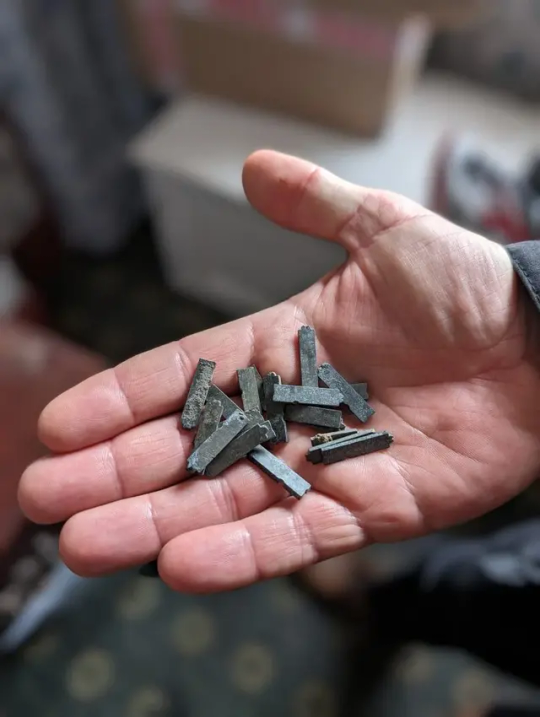
Using historical accounts and Cobden-Sanderson’s diaries, he pinpointed the exact spot where the printer had offloaded his wares, from a shadowy spot on Hammersmith bridge. “I’d only been down there 20 minutes and I found three pieces,” he said. “So, I got in touch with the Port of London Authority and they came down to search in a meticulous spiral.” The team of scuba divers used the rather low-tech tools of a bucket and a sieve to sift through the riverbed.
Green managed to recover a total of 151 sorts (the name for individual pieces of type) out of a possible 500,000. “It’s a tiny fraction, but when I was down by the river on my own, for one second it all felt very cosmic,” he said. “It was like Cobden-Sanderson had dropped the type from the bridge and straight into my hands. Time just collapsed.”
The finds have enabled him to further develop his digitized version and has also connected him with official mudlarks (people who search riverbanks for lost treasures, with special permits issued) who have uncovered even more of the type.
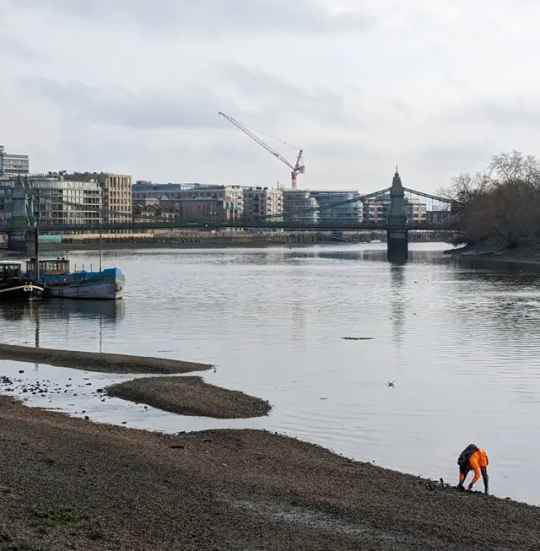
Jason Sandy, an architect, author and member of the Society of Thames Mudlarks, found 12 pieces, which he has donated to Emery Walker’s House at 7 Hammersmith Terrace. This private museum was once home to both business partners, and retains its stunning domestic Arts and Crafts interior.
Much like Green, Sandy was captivated by the Doves Type story, and mounted an exhibition at the house that displays hundreds of these salvaged pieces, including those discovered by Green, as well as mudlarks Lucasz Orlinski and Angus McArthur. The show was supplemented by a whole host of Sandy’s other finds, including jewelry and tools. An extant copy of the Doves English Bible is also on display.
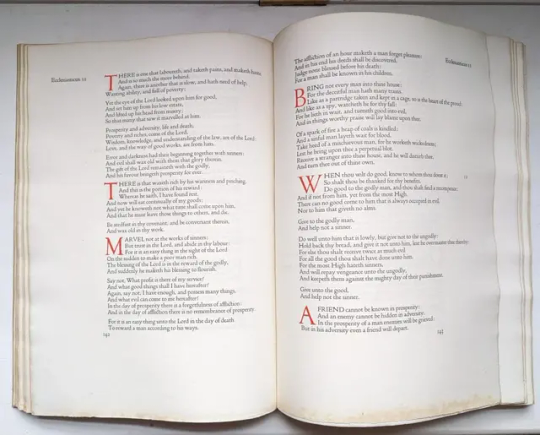
“It is not that unusual to find pieces of type in the river,” Sandy said. “Particularly around Fleet Street, where newspaper typesetters would throw pieces in the water when they couldn’t be bothered to put them back in their cases. But this is a legendary story and we mudlarks love a good challenge.” The community is naturally secretive about exactly where and how things are found. For example, Orlinski has worked under the cover of night with a head torch, to search for treasures at his own mysterious spot on the riverbank.
For Sandy, the thrill comes from the discovery of both rare and everyday artifacts, which can lead to an entirely new line of inquiry: “The Thames is very democratic. It gives you a clear picture of what people have been wearing or using over thousands of years. And it’s not carefully curated by a museum. The river gives up these objects randomly, and you experience these amazing stories of ordinary Londoners. It creates a very tangible connection to the past. Every object leads you down a rabbit hole.”
By Holly Black.
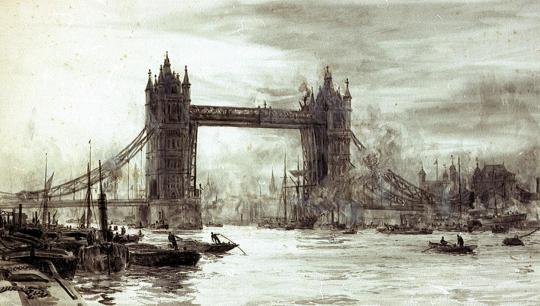
#Remnants of a Legendary Typeface Have Been Rescued From the Thames River#Doves Type#printer#Society of Thames Mudlarks#mudlark#mudlarking#ancient#archeology#archeolgst#history#history news#long reads#long post
108 notes
·
View notes
Text
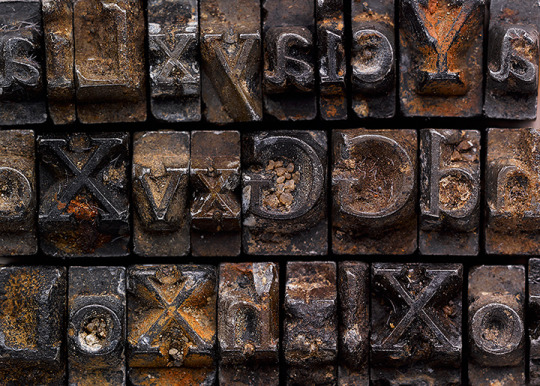
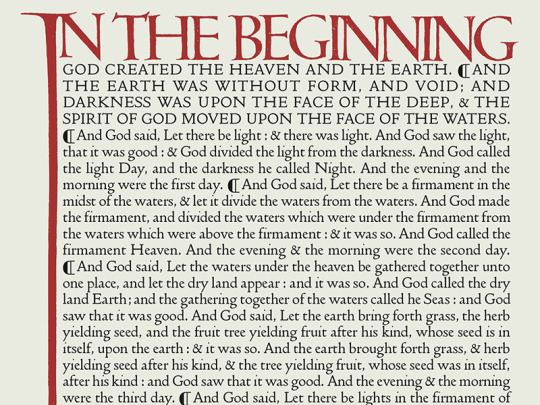
The Doves Type was a typeface created by T.J. Cobden-Sanderson and Emery Walker of The Doves Press, founded in 1900. When the partnership was eventually dissolved in 1909 after a bitter dispute, ownership of the Dove Type was appointed to Cobden-Sanderson, whereupon his death the ownership would pass to Walker.
Rather than let this happen, Cobden-Smith began to dispose of the type matrices into the River Thames off Hammersmith Bridge. Cobden-Sanderson wrote in his personal journals that he "bequeathed to the river" the type itself. Beginning in 1916, under the cloak of midnight, Cobden-Sanderson began the slow task of disposing of Doves into the river. He said that he completed the task in January 1917 after 170 trips in total to the bridge.
Over 150 pieces of the typeface were recovered from the riverbed by Robert Green in 2014, with the help of the Port of London Authority and the acquisition of a mudlarking license.
#doves type#doves font#typology#edwardian#edwardian era#edwardian london#mudlarking#mudlark#archaeology#history#london#london history#river thames#thames river#thames#british history
13 notes
·
View notes
Text
The depths of the river Thames in London hold many unexpected stories, gleaned from the recovery of prehistoric tools, Roman pottery, medieval jewelry, and much more besides. Yet the tale of the lost (and since recovered) Doves typeface is surely one of the most peculiar.
A little over a century ago, the printer T.J. Cobden-Sanderson took it upon himself to surreptitiously dump every piece of this carefully honed metal letterpress type into the river. It was an act of retribution against his business partner, Emery Walker, whom he believed was attempting to swindle him.
The pair had conceived this idiosyncratic Arts and Crafts typeface when they founded the Doves Press in the London’s Hammersmith neighborhood, in 1900. They worked with draftsman Percy Tiffin and master punch-cutter Edward Prince to faithfully recall the Renaissance clarity of 15th-century Venetian fonts, designed by the revolutionary master typographer Nicolas Jensen.
With its extra-wide capital letters, diamond shaped punctuation and unique off-kilter dots on the letter “i,” Doves Type became the press’s hallmark, surpassing fussier typographic attempts by their friend and sometime collaborator, William Morris.
The letterforms only existed as a unique 16pt edition, meaning that when Cobden-Sanderson decided to “bequeath” every single piece of molded lead to the Thames, he effectively destroyed any prospect of the typeface ever being printed again. That might well have been the case, were it not for several individuals and a particularly tenacious graphic designer.
0 notes
Photo
A little over a century ago, the printer T.J. Cobden-Sanderson took it upon himself to surreptitiously dump every piece of this carefully honed metal letterpress type into the river. It was an act of retribution against his business partner, Emery Walker, whom he believed was attempting to swindle him.
...
The letterforms only existed as a unique 16pt edition, meaning that when Cobden-Sanderson decided to “bequeath” every single piece of molded lead to the Thames, he effectively destroyed any prospect of the typeface ever being printed again. That might well have been the case, were it not for several individuals and a particularly tenacious graphic designer.


(via Remnants of a Legendary Typeface Have Been Rescued From the River Thames)
692 notes
·
View notes
Photo
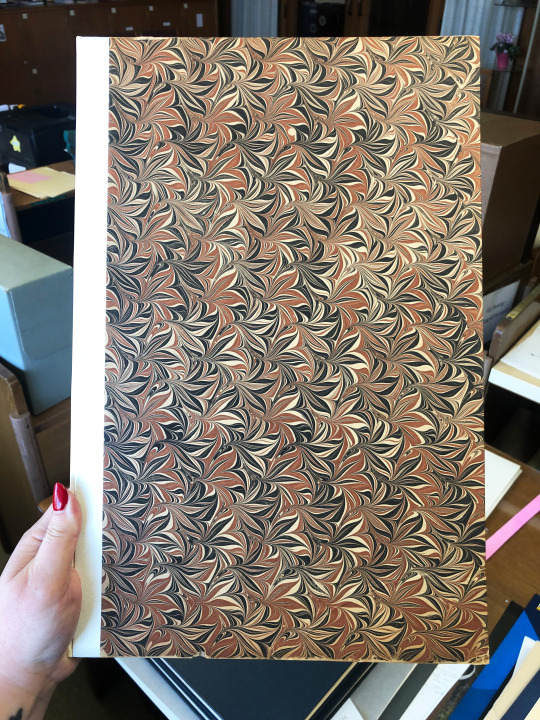
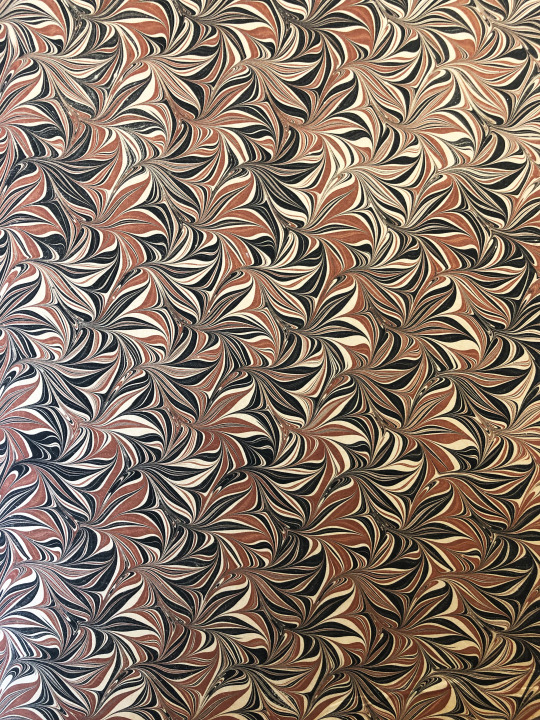



Marbled Monday
It’s time for another Marbled Monday! This week we have some gorgeous marbling found in the binding of C-S The Master Craftsman by American book collector and businessman Norman H. Strouse and British book designer and historian of print John Dreyfus. The book includes two essays about English artist and bookbinder T.J. Cobden-Sanderson, each by one of the authors. It was published in 1969 by the Adagio Press in Harper Woods, Michigan and printed by Leonard Bahr, who founded the Adagio Press. Printed in Palatino type designed by Hermann Zapf, the book is printed on handmade Tovil paper, which was printed dry (usually this type of paper is best printed on damp). Bahr explains in the colophon that there were many issues faced while printing the book, namely time (owing to the fact that “The Adagio Press is a sparetime printing activity, confined to the evening and weekend hours available after normal employment”) and the number of pages able to be set at one time due to the amount of type owned by the press. The book was printed in an edition of 329 copies. Our copy is another gift from our friend Jerry Buff.
Oddly enough, the 2-page colophon doesn’t mention the marbled paper used for the binding! The marbling pattern isn’t to be found in my trusty reference from the University of Washington Libraries and appears to be a unique, floral or foliage-inspired design. Done in cream, black, and red, the pattern features flowers or leaves with the colors swirled together. It’s interesting and lovely, especially when you get up really close to see the swirly interstitial bits.
View more Marbled Monday posts.
VIew more posts about work by the Adagio Press.
-- Alice, Special Collections Department Manager
#The Adagio Press#Marbled Monday#T.J. Cobden-Sanderson#Norman H. Strouse#John Dreyfus#Leonard Bahr#Adagio Press#marbled paper#patterned paper#marbling#Palatino#Hermann Zapf#Jerry Buff
49 notes
·
View notes
Photo

‘Sigurd the Volsung’ by William Morris (1834-1896).
Red morocco and gilt binding by T.J. Cobden-Sanderson; dated 1889.
Published by Reeves & Turner.
Image and text information courtesy The Morgan Library and Museum.
57 notes
·
View notes
Photo



We find it fascinating that Thomas James Cobden-Sanderson (1840-1922)--the proprietor of the esteemed Doves Press, a fine press known for its beautiful typography, having great clarity and grace (see top, a detail of a leaf on vellum from the Doves Bible)--had such terrifically difficult handwriting to decipher (middle and bottom image), one of several letters by the lawyer-turned-publisher in our special collections...
30 notes
·
View notes
Text
What was the “private press movement?” Who founded the Kelmscott Press and the Doves Press? How were the ideals of the Arts and Crafts Movement expressed in the design and making of Arts and Crafts books?
The Private Press movement was a revival in letterpress printing. The Kelmscott Press was founded by William Morris and Doves Press was founded by T.J. Cobden-Sanderson. The ideals of the Arts and Crafts Movement expressed in the design and making of Arts and Crafts books were that they were more compatible amid villages rather than in urban conditions.
0 notes
Photo

May your new year be half as ambitious and twice as successful as bookbinder T.J. Cobden-Sanderson's https://t.co/AC17tnx4TR
— James Misson (@J_Misson) Jan 5, 2022
0 notes
Photo

Ese año (por fin) se viene el primer William Morris en Barba de Abejas: . El arte de hacer libros contiene "Imprimir" de WM y Emery Walker, "Encuadernar" de T.J. Cobden-Sanderson, la nota de WM sobre su intención al fundar la Kelmscott Press y la breve historia de esta editorial (madre de la edición artesanal) escrita por S.C. Cockerell. . Todavía en proceso de traducción, but stay tuned, folks! #barbadeabejas #edicionartesanal #edicionindependiente #kelmscottpress #williammorris #emerywalker #tjcobden-sanderson #imprimir #encuadernar #diy #diyordie https://www.instagram.com/p/B815H-0lN7T/?igshid=g8ybhznf6zq7
#barbadeabejas#edicionartesanal#edicionindependiente#kelmscottpress#williammorris#emerywalker#tjcobden#imprimir#encuadernar#diy#diyordie
0 notes
Text

Capa feita por T.J. Cobden Sanderson em 1891 para o livro Poemas de Dante Gabriel Rossetti (1870).
0 notes
Photo





Typography Tuesday: Doves Type
The Doves Press was founded in 1901 by Emery Walker and Thomas J. Cobden-Sanderson. Walker, an expert in 16th-century type design, had inspired William Morris to found the Kelmscott Press, and remained a close friend and adviser to Morris until Morris’s death in 1896. Cobden-Sanderson was founder of the Doves Bindery in 1893, and was also very close to Morris and bound much of Kelmscott’s output. Walker and Cobden-Sanderson combined their talents to establish the Doves Press with financing from Cobden-Sanderson‘s socialist and suffragist wife Anne.
Cobden-Sanderson, Walker, and Morris’s former secretary Sydney Cockerell oversaw the design of the proprietary typeface which was based on Nicolas Jenson’s Roman type of the 1470s. This single typeface was used for every edition that came off the press, and ownership of the type was intended to be shared by the two proprietors. Unfortunately, the two had a falling out over the direction of the press, and their partnership was dissolved in 1908. In 1909, they made an agreement that the type could continue to be used by Cobden-Sanderson, and ownership would go to whoever outlived the other. They did not agree, however, on how the type could be used. Walker believed it should be used commercially, to which Cobden-Sanderson was adamantly opposed.
To spite Walker, Cobden-Sanderson dumped all the matrices for the type into the Thames in 1913. The Press finally closed in 1916, and in a further act of spite, Cobden-Sanderson famously (or infamously), over a period of time and in the dead of night, “bequeathed” the entire font of type to the Thames. T.J. Cobden-Sanderson died in 1922, and after his death, Anne Cobden-Sanderson paid a large sum to settle the dispute with Emery Walker.
For almost 100 years the type was thought to be lost forever, until late last year when designer Robert Green, who for years had been working to recreate the type, dredged the Thames near Hammersmith Bridge, the site of the dumping, with the aid of the Port of London Authority. Remarkably, the type had hardly moved in the intervening century, and 150 pieces of the original type were recovered.
As an example of this famous typeface we present our copy of the 1910 Doves Press edition of Robert Browning’s Dramatis Personae (another exquisite donation from our long-time benefactor Jerry Buff). The copy is inscribed by the printer T.J. Cobden-Sanderson, “To Marie Little with the best of wishes from her ever well-wishing friends, T.J. and Annie Cobden-Sanderson May 1912.” The printing was limited to an edition of 250 copies in red and black on handmade paper, and bound in full limp vellum by the Doves Bindery.
View more posts from our Typography Tuesday series.
#Typography Tuesday#Doves Type#Doves Press#T.J. Cobden-Sanderson#Emery Walker#back-stabbing#Jerry Buff#20th century
21 notes
·
View notes